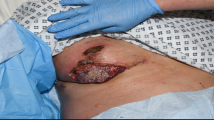Abstract
Background
Pyoderma gangrenosum (PG) is a rare inflammatory cutaneous disorder. Although PG is a diagnosis of exclusion, prompt recognition is essential to attain the desired outcomes. From an aesthetic standpoint, this is especially critical with breast involvement and other body segments. We present a consecutive case series of four patients who developed PG following breast surgery and responded to early intervention.
Methods
A chart review identified four patients who were identified as having developed PG after either aesthetic or reconstructive breast surgery. Their histories, associated risk factors, diagnosis, course of treatment, and results were documented. The PubMed database was then searched to find the literature for comparison.
Results
The average time from surgery to the onset of symptoms was 11 days, and the average time from the onset of symptoms to the correct diagnosis of PG was 41 days. The average length of steroid therapy was 25 days. The average time from the initiation of steroids to complete wound closure was 51 days. The average time from the onset of symptoms to complete wound closure bilaterally was 87 days. All wounds healed with conservative management.
Conclusion
Postsurgical PG is a rare but recognized cause of postoperative wound breakdown in patients who have undergone plastic surgery procedures to the breast. Early recognition and treatment can facilitate prompt reversal of the inflammatory process leading to complete wound healing and limitation of the morbidity that can be associated with the disease.
Level of Evidence V
This journal requires that authors assign a level of evidence to each article. For a full description of these Evidence-Based Medicine ratings, please refer to the Table of Contents or the online Instructions to Authors www.springer.com/00266.



Similar content being viewed by others
References
Papilion JD, Bergfield TG (1990) Pyoderma gangrenosum complicating infection of the hand a case report and review of the literature. Clin Orthop Relat Res. https://doi.org/10.1097/00003086-199005000-00022
Zelones JT, Nigriny JF (2017) Pyoderma gangrenosum after deep inferior epigastric perforator breast reconstruction: systematic review and case report. Plast Reconstr Surg Global Open. https://doi.org/10.1097/GOX.0000000000001239
Patel F, Fitzmaurice S, Duong C et al (2015) Effective strategies for the management of pyoderma gangrenosum: a comprehensive review. Acta Dermato Venereol. https://doi.org/10.2340/00015555-2008
Ehrl DC, Heidekrueger PI, Broer PN (2018) Pyoderma gangrenosum after breast surgery: a systematic review. J Plast Reconstr Aesthetic Surg. https://doi.org/10.1016/j.bjps.2018.03.013
Tuffaha SH, Sarhane KA, Mundinger GS et al (2016) Pyoderma gangrenosum after breast surgery: diagnostic pearls and treatment recommendations based on a systematic literature review. Ann Plast Surg. https://doi.org/10.1097/SAP.0000000000000248
Lemos AC, Aveiro D, Santos N, Marques V, Pinheiro LF (2017) Pyoderma gangrenosum: an uncommon case report and review of the literature. Wounds 29(9):E61–E69
Rand RP, Brown GL, Bostwick J (1988) Pyoderma gangrenosum and progressive cutaneous ulceration. Ann Plast Surg. https://doi.org/10.1097/00000637-198803000-00019
Wustrack KO, Zarem HA (1978) Pyoderma Gangrenosum. Plast Reconstr Surg. https://doi.org/10.1097/00006534-197809000-00014
Larcher L, Schwaiger K, Eisendle K et al (2015) Aesthetic breast augmentation mastopexy followed by post-surgical pyoderma gangrenosum (PSPG): clinic, treatment, and review of the literature. Aesthetic Plast Surg. https://doi.org/10.1007/s00266-015-0499-3
Simon AM, Khuthaila D, Hammond DC, Andres A (2006) Pyoderma gangrenosum following reduction mammaplasty. Can J Plast Surg 14(1):37–40
Zuo KJ, Fung E, Tredget EE, Lin AN (2014) A systematic review of post-surgical pyoderma gangrenosum: identification of risk factors and proposed management strategy. J Plast Reconstr Aesthetic Surg. https://doi.org/10.1016/j.bjps.2014.12.036
Pichler M, Larcher L, Holzer M et al (2016) Surgical treatment of pyoderma gangrenosum with negative pressure wound therapy and split thickness skin grafting under adequate immunosuppression is a valuable treatment option: case series of 15 patients. J Am Acad Dermatol. https://doi.org/10.1016/j.jaad.2015.09.009
Canzoneri C, Taylor D, Freet D (2018) Is prophylactic immunosuppressive therapy for patients with a history of postsurgical pyoderma gangrenosum necessary? J Cutaneous Aesthetic Surg 11(4):234. https://doi.org/10.4103/jcas.jcas_98_17
Touil LL, Gurusinghe DA, Sadri A, El-Gawad A, Fahmy FS (2017) Postsurgical pyoderma gangrenosum versus necrotizing fasciitis. Ann Plast Surg 78(5):582–586. https://doi.org/10.1097/sap.0000000000001070
Fria Ancona G, Hierro Orozco S (1998) Neutrophilic dermatosis. Rev Alerg Mex. https://doi.org/10.2165/11310730-000000000-00000
Ormerod AD, Thomas KS, Craig FE, Mitchell E, Greenlaw N, Norrie J, Williams HC (2015) Comparison of the two most commonly used treatments for pyoderma gangrenosum: results of the STOP GAP randomised controlled trial. BMJ. https://doi.org/10.1136/bmj.h2958
Vilches FS, Vera-Kellet C (2017) Pyoderma gangrenosum: classic and emerging therapies. Med Clín (Engl Ed) 149(6):256–260. https://doi.org/10.1016/j.medcle.2017.08.007
Sheldon DG, Sawchuk LL, Kozarek R (2000) Twenty cases of peristomal pyoderma gangrenosum. Arch Surg 135(5):564. https://doi.org/10.1001/archsurg.135.5.564
Apalla Z, Lallas A, Karteridou A, Sotiriou E, Papaioannou K, Chaidemenos G (2012) Pyoderma gangrenosum complicating mammaplasty. Int Wound J. https://doi.org/10.1111/j.1742-481X.2011.00916.x
Author information
Authors and Affiliations
Corresponding author
Ethics declarations
Conflict of interest
The authors declare that they have no conflicts of interest to disclose.
Statement of human and animal rights, or ethical approval
This article does not contain any studies with human participants or animals performed by any of the authors.
Informed consent
For this type of study, informed consent is not required.
Additional information
Publisher's Note
Springer Nature remains neutral with regard to jurisdictional claims in published maps and institutional affiliations.
Rights and permissions
About this article
Cite this article
Hammond, D., Chaudhry, A., Anderson, D. et al. Postsurgical Pyoderma Gangrenosum After Breast Surgery: A Plea for Early Suspicion, Diagnosis, and Treatment. Aesth Plast Surg 44, 2032–2040 (2020). https://doi.org/10.1007/s00266-020-01899-5
Received:
Accepted:
Published:
Issue Date:
DOI: https://doi.org/10.1007/s00266-020-01899-5




